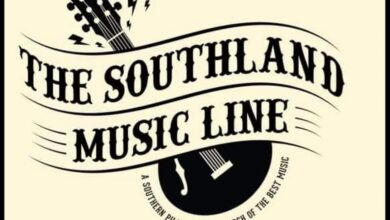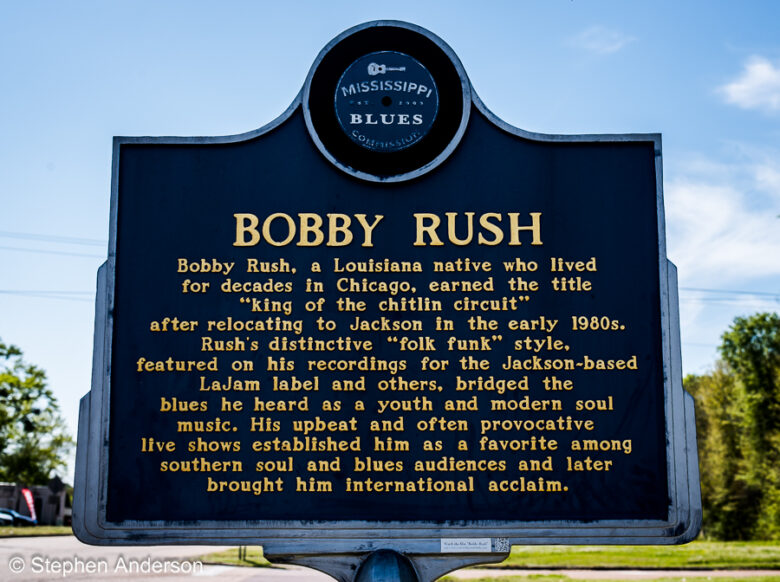Mississippi Blues Trail Series – Jimmie Rodgers and The Blues
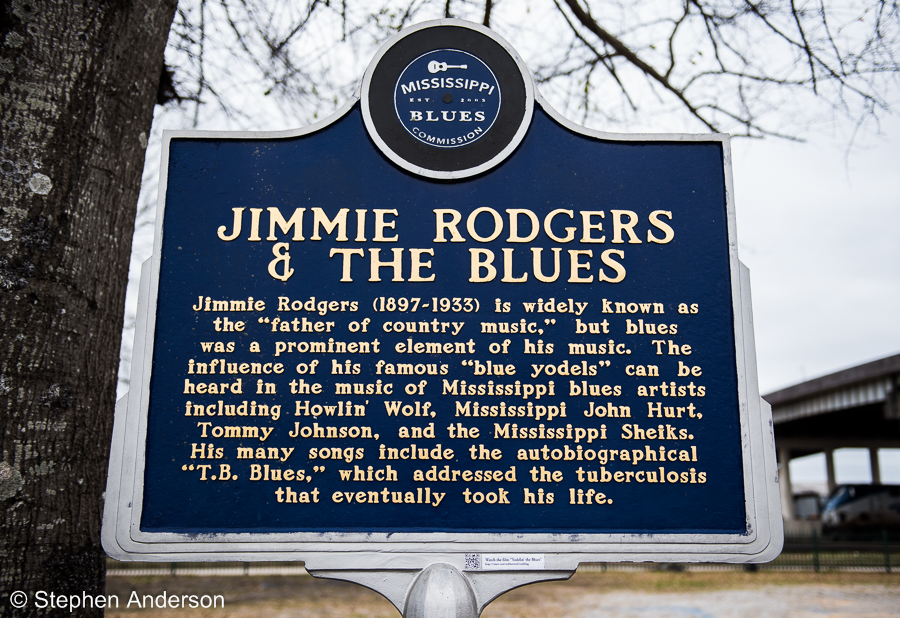
by Johnny Cole
Photos by Stephen Anderson
Additional Editing by Brenda Germany
The Southland Music Line continues our Mississippi Blues Trail Series in Meridian, Mississippi at the marker recognizing the great Jimmie Rodgers. We have visited several markers from this area of the state in 2022 and written articles spotlighting the markers dedicated to Howlin’ Wolf and Peavey Electronics.
The Mississippi Blues Trail marker honoring the legendary Jimmie Rodgers, “The Father of Country Music”, is located in Singing Brakeman Park adjacent to Union Station in beautiful, historic downtown Meridian at 1901 Front Street. James Charles Rodgers (1897-1933), known for his distinctive rhythmic yodeling, rose to national prominence during the late 1920’s and early 1930’s becoming the first major star of country music. The singer-songwriter is highly regarded for his enormous influence on both country music and the blues. Nicknamed “Singing Brakeman” and “The Blue Yodeler”, the innovative Rodgers has received multiple honors including being inducted into the Country Music Hall of Fame in 1961, Songwriters Hall of Fame in 1970, The Rock and Roll Hall of Fame (as an “early influence”) in 1986 and the Blues Hall of Fame in 2013. Rodgers’ “Blue Yodel No. 9” was also selected as one of The Rock and Roll Hall of Fame’s 500 Songs that Shaped Rock and Roll.
* NOTE: The Mississippi born Rodgers should not be confused with the successful pop artist of the same name, known for such 1950’s hit singles as “Honeycomb” and “Kisses Are Sweeter Than Wine”.
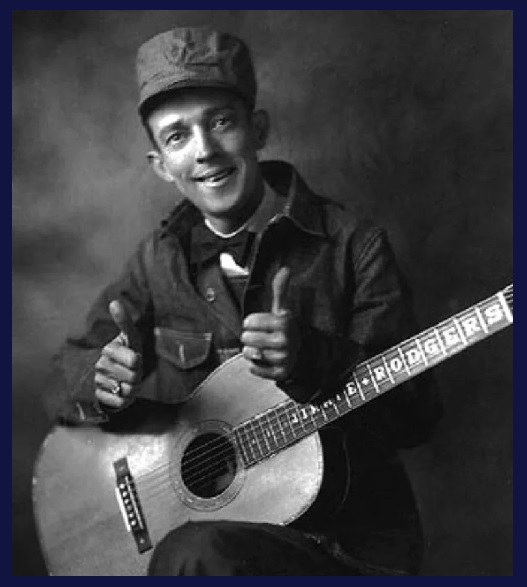 Top photo: The Jimmie Rodgers’ Mississippi Blues Trail marker in Meridian, MS; Above photo: The famous photo of Jimmie Rodgers “The Singing Brakeman” that appears on the Mississippi Blues Trail marker (Getty Images)
Top photo: The Jimmie Rodgers’ Mississippi Blues Trail marker in Meridian, MS; Above photo: The famous photo of Jimmie Rodgers “The Singing Brakeman” that appears on the Mississippi Blues Trail marker (Getty Images)
From country music to rock and roll to the blues, a diverse and staggering number of music artists such as Alison Krauss & Union Station, The Beatles, Bob Dylan, Elton John, Ernest Tubbs, Jerry Garcia, John Mellencamp, Johnny Cash, Leon Russell, Lynyrd Skynyrd, Merle Haggard, U2’s Bono, Waylon Jennings, Willie Nelson and others have paid tribute to the music of Jimmie Rodgers. The King of Rock & Roll, Elvis Presley, was once quoted as mentioning Rodgers as an important influence, stating he was a big fan. Singer-songwriter and fellow Meridian native, Steve Forbert (popular for his 1979 single “Romeo’s Tune”) released his Grammy nominated Jimmie Rodgers’ tribute album “Any Old Time: The Songs of Jimmie Rodgers” to much acclaim in 2004 (co-produced by the E Street Band’s Garry Tallent).
During the height of his popularity, Rodgers undoubtedly did more to popularize the blues than any other performer of his time, black or white. In our recent article on blues great, Chester Arthur Burnett a.k.a. Howlin Wolf, we learned that Rodgers was Burnett’s childhood idol and when the popular Burnett tried to emulate Rodgers’ yodel, his efforts sounded more like a growl or a howl, which served him well. Several more blues artists, including Big Bill Broonzy, Walter E. “Furry” Lewis, Mississippi Sheiks, Muddy Waters, Scott Dunbar and Tommy Johnson were influenced by Rodgers, too. The song, “Let the Mermaids Flirt With Me”, by Mississippi John Hurt (a blues legend featured in one of our articles in 2019) was based on Rodgers’ hit “Waiting for a Train”. Interestingly, more than a third of Rodgers’ music were blues recordings, which he encountered as a young man while working as a railway brakeman and traveling musician. Rodgers’ highly popular “Blue Yodels,” a series of thirteen songs that blended several styles of music composed in blues format earned him the nickname “The Blue Yodeler”.
The majority of Rodgers’ songs were original, but he did record some versions or adaptations of early blues classics. Plus, Rodgers frequently employed African American musicians in the studio, including Louis Armstrong and his wife Lil on the classic “Blue Yodel No. 9” (recorded on July 16, 1930 in Los Angeles; both Louis Armstrong on trumpet and his wife Lil Hardin Armstrong on piano were unbilled). Further proving his deep connections with the blues, Rodgers performed alongside many blues musicians and singers from that era, including as part of a vaudeville show that featured blues singer Eva Taylor, wife of Clarence Williams, a producer for Okeh Records, publisher, and piano player. Bluesmen such as Hammie Nixon, Rubin “Rube” Lacy, and Houston Stackhouse also claim to have traveled and performed with Rodgers during the ’20s and ’30s.
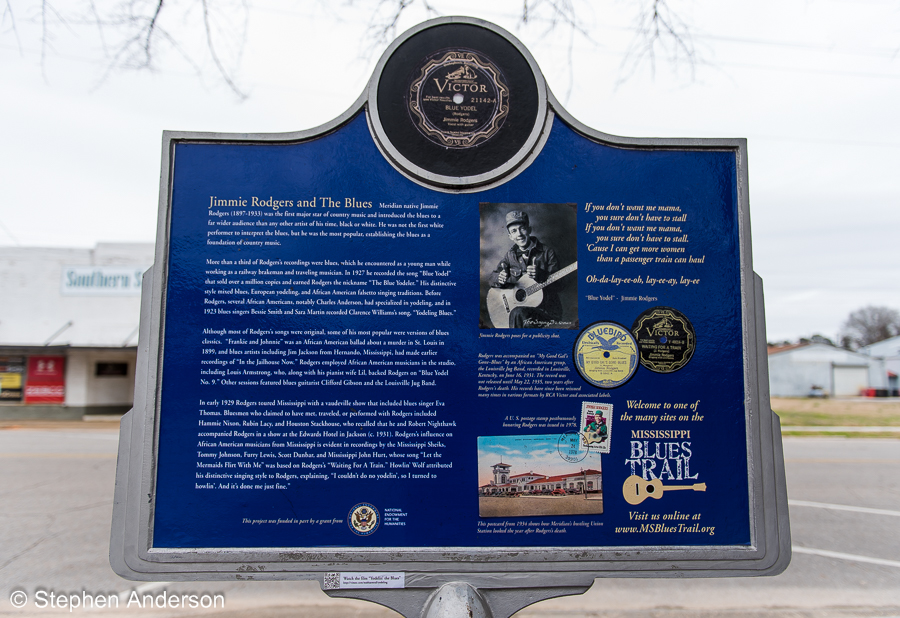 The reverse side of the Jimmie Rodgers’ Mississippi Blues Trail marker in Meridan, MS
The reverse side of the Jimmie Rodgers’ Mississippi Blues Trail marker in Meridan, MS
Jimmie Rodgers, born September 8, 1897, usually has Meridian, Mississippi listed as his birthplace, though some birth documents point to his paternal grandparents home of Geiger, Alabama. Yet, several historians seem to identify the community of Pine Springs, Mississippi, just north of Meridian, as his rightful birthplace. Following the death of his mother, Eliza (Bozeman) Rodgers, when he was six or seven years old, Rodgers (the youngest of three sons; one of possibly seven children) spent much of his young life living with relatives in Mississippi and Alabama. He eventually returned home to live with his father, Aaron Rodgers, a maintenance foreman on the Mobile and Ohio Railroad, who lived with his new wife in Meridian. At a very early age and for much of his life, Rodgers worked on the railroad, including as a brakeman on the New Orleans and Northeastern Railroad. Sadly, in 1924 at age 27, Jimmie Rodgers was diagnosed with tuberculosis, which temporarily limited his work on the railroad. For a short time, he made further attempts at pursuing his career in music by organizing a traveling road show and performed across the southeastern United States, but that came to an abrupt end when a storm destroyed his tent forcing him back into the railroad work. After spending time in both Florida and Arizona working on the railroad, he and his family finally returned to Meridian in 1927, which by then included wife Carrie and daughter Anita (he and Carrie had a second daughter, June Rebecca Rodgers, who died at six months old in 1923).
For many years Rodgers pursued a career in music, but it was a few years after receiving the bad news of his sickness when he eventually found success. In the spring of 1927, Rodgers traveled to Asheville, North Carolina and performed on WWNC, Asheville’s first radio station. A few months later, a weekly slot was secured on the station lineup for Rodgers and a recruited group of musicians from Bristol, Tennessee, which became “The Jimmie Rodgers Entertainers”. By mid-summer, Rodgers and his bandmates learned Ralph Peer, a representative of the Victor Talking Machine Company, was coming to Bristol to hold an audition for local musicians. Later to become known as the Bristol Sessions, these now famous recording sessions marked the commercial debuts of Jimmie Rodgers and the Carter Family. As a result of the influence of these legendary sessions, Bristol has been called the “birthplace of country music”. Following a dispute with bandmates, Rodgers recorded two songs alone during the Bristol Sessions for $100.
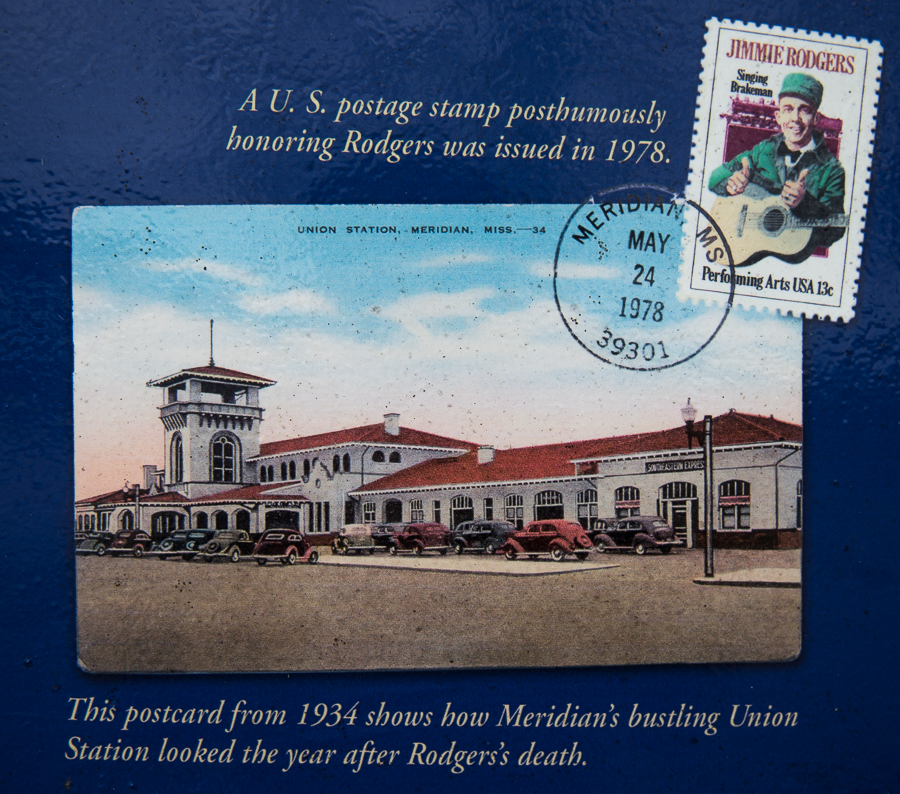 U.S. Stamp (issued in 1978) and postcard of Union Station in Meridian, MS (from 1934, the year after Rodgers’ death.
U.S. Stamp (issued in 1978) and postcard of Union Station in Meridian, MS (from 1934, the year after Rodgers’ death.
More determined than ever, Rodgers traveled to New York City in the autumn of that same year to arrange more sessions with Peer. Rodgers’ recordings at Victor studios in Camden, New Jersey would lead him to stardom. His recording of “Blue Yodel” (Blue Yodel No. 1 “T for Texas”) spent 14 weeks atop the Victor sales list. Eventually selling over a million copies, this classic hit became Rodgers’ career top seller. In 1930, Rodgers sang the song in his Columbia Pictures short film The Singing Brakeman.
An interesting fact: When arranging additional recording sessions with Victor, Rodgers requested that his sister-in-law, Elsie McWilliams, a musician, help him write some songs. Even though credited with less, she would write nearly 40 songs with Rodgers. McWilliams, born in Harperville, Mississippi, was the first woman to make a career as a country music songwriter.
During the Great Depression, Jimmie Rodgers moved to San Antonio where he did a weekly radio show following his early success. Despite his battle with tuberculosis, Rodgers remained busy recording new music and touring, which did little to help his ailing condition. In May of 1933, Rodgers returned to New York City for what would be his final recording sessions. Even though he was able to record new music, his declining health forced him to have a nurse accompany him to his final recording session while a cot was used for him to rest between songs. The final song recorded by Rodgers was “Years Ago”. Two days after his final session, Jimmie Rodgers died in his New York City hotel room on May 26, 1933. Rodgers was only 35 years old. His body, placed in a pearl grey coffin, was sent by train back to Meridian where he was buried at Oak Grove Cemetery.
On May 3, 2007, Jimmie Rodgers was honored with a marker on the Mississippi Blues Trail. Three years later in May of 2010 a marker on the Mississippi Country Music Trail was erected near Rodgers’ gravesite.
Jimmie Rodgers is one of the most cherished recording artists in music history. His distinctive style mixed blues, European yodeling, and African American falsetto singing traditions, popularizing it to a huge audience and inspiring future music artists. He left behind such time-honored classic recordings as “Blue Yodel No. 1 (T For Texas)”, “The Brakeman’s Blues”, “Waiting for a Train”, “Any Old Time”, “Miss the Mississippi and You”, “T.B. Blues”, “Blue Yodel No. 9 (Standing on the Corner)”, “In the Jailhouse Now”, “Travellin’ Blues” and more.
We invite you to continue joining us as we travel across the state and abroad celebrating the music and musicians honored by the Mississippi Blues Trail and legions of loyal music fans.
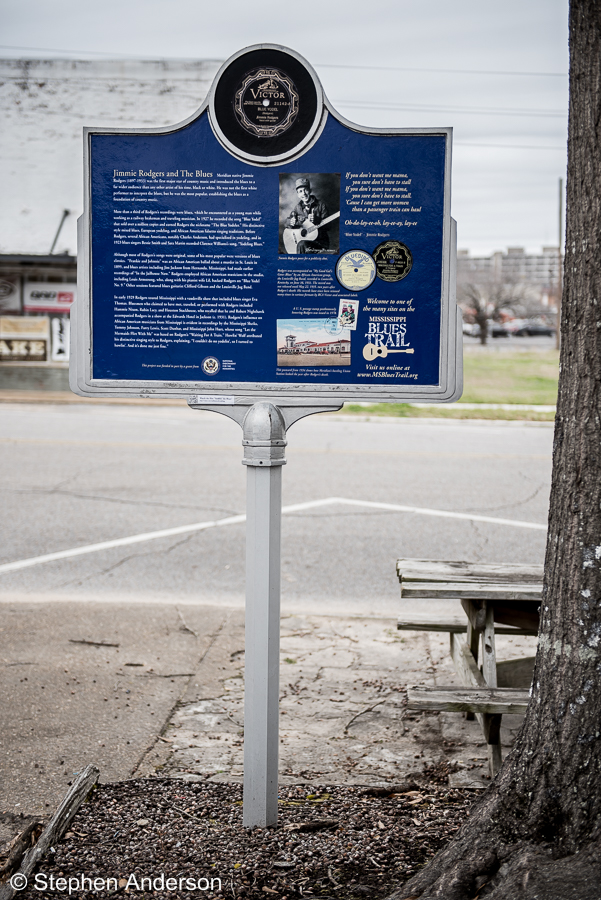 The Mississippi Blues Trail marker honoring the legendary Jimmie Rodgers (located at 1901 Front Street. Meridian, MS)
The Mississippi Blues Trail marker honoring the legendary Jimmie Rodgers (located at 1901 Front Street. Meridian, MS)
Click Here for Other Articles in our Mississippi Blues Trail Series.
Credits:
1) Jimmie Rodgers Festival & Museum official website.
2) Jimmie Rodgers Country Music Hall of Fame official website.
3) Jimmie Rodgers: American Singer – Encyclodepedia Britannica
4) The Tennessean – Jimmie Rodgers
5) Mississippi Blues Trail
Page Designed & Edited by Johnny Cole
Additional Editing by Brenda Germany
© The Southland Music Line. 2022.
All rights reserved

COPYRIGHT NOTICE: We welcome requests for permission to use content from The Southland Music Line website and Facebook page. Any shared articles or photos may not be altered, edited nor cropped and must include the appropriate copyrights of The Southland Music Line.


